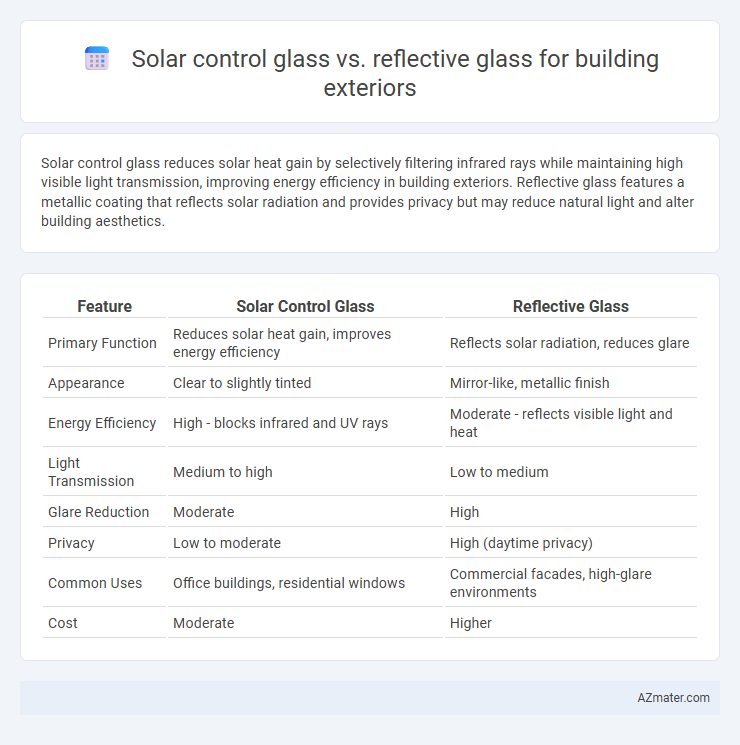Solar control glass reduces solar heat gain by selectively filtering infrared rays while maintaining high visible light transmission, improving energy efficiency in building exteriors. Reflective glass features a metallic coating that reflects solar radiation and provides privacy but may reduce natural light and alter building aesthetics.
Table of Comparison
| Feature | Solar Control Glass | Reflective Glass |
|---|---|---|
| Primary Function | Reduces solar heat gain, improves energy efficiency | Reflects solar radiation, reduces glare |
| Appearance | Clear to slightly tinted | Mirror-like, metallic finish |
| Energy Efficiency | High - blocks infrared and UV rays | Moderate - reflects visible light and heat |
| Light Transmission | Medium to high | Low to medium |
| Glare Reduction | Moderate | High |
| Privacy | Low to moderate | High (daytime privacy) |
| Common Uses | Office buildings, residential windows | Commercial facades, high-glare environments |
| Cost | Moderate | Higher |
Introduction to Solar Control Glass and Reflective Glass
Solar control glass reduces heat gain by filtering infrared solar radiation while maintaining high visible light transmission, making it ideal for energy-efficient building exteriors. Reflective glass features a thin metallic coating that reflects solar energy and enhances privacy by producing a mirror-like surface on one side. Both types optimize thermal performance and occupant comfort but differ in aesthetics and light management capabilities.
How Solar Control Glass Works
Solar control glass reduces heat gain by filtering and blocking solar radiation using specialized coatings that reflect and absorb infrared wavelengths while allowing visible light to pass through. This glass technology minimizes cooling loads and enhances indoor comfort without compromising natural daylight. Unlike reflective glass, which primarily creates a mirrored appearance and reflects significant visible light, solar control glass offers balanced energy efficiency and transparency for building exteriors.
Functionality of Reflective Glass in Building Exteriors
Reflective glass in building exteriors enhances energy efficiency by minimizing solar heat gain and glare while maintaining natural daylight, creating a comfortable indoor environment. Its mirrored surface effectively reflects infrared and visible light, reducing cooling loads and preventing excessive heat buildup inside structures. Additionally, reflective glass improves privacy and aesthetic appeal, making it a practical choice for modern architectural designs focused on sustainability and occupant comfort.
Key Differences Between Solar Control Glass and Reflective Glass
Solar control glass primarily reduces solar heat gain by selectively filtering infrared and UV rays, improving energy efficiency and indoor comfort without significantly altering the building's appearance. Reflective glass features a metallic coating that reflects a high percentage of visible light, offering enhanced privacy and a mirror-like exterior finish while also reducing glare. The key difference lies in their function and aesthetic impact: solar control glass minimizes heat transmission with a subtle look, whereas reflective glass emphasizes visual reflectivity and exterior privacy.
Energy Efficiency: Solar Control vs Reflective Glass
Solar control glass optimizes energy efficiency by selectively filtering solar radiation while allowing natural light, reducing cooling loads and enhancing indoor comfort without significantly darkening interiors. Reflective glass achieves energy savings primarily through its mirrored coating that reflects a large portion of solar heat away, but it can reduce visible light transmission and alter building aesthetics. Choosing between the two depends on balancing energy performance goals with daylight requirements and exterior appearance preferences.
Aesthetic Impact on Building Design
Solar control glass enhances building exteriors by offering a sleek, neutral appearance that preserves natural light while reducing heat gain, enabling architects to maintain modern and clean design aesthetics. Reflective glass creates a distinctive mirrored surface that can dramatically alter a building's appearance, adding a bold, contemporary look and improving privacy by reflecting the surrounding environment. Both materials impact building aesthetics differently, with solar control glass emphasizing subtle integration and reflective glass providing strong visual statements.
Durability and Maintenance Requirements
Solar control glass offers enhanced durability due to its specialized coatings that resist UV degradation and minimize fading, making it ideal for long-term performance in building exteriors. Reflective glass, while effective at reducing solar heat gain, may require more frequent cleaning and maintenance to manage surface dirt and maintain its reflective properties. Both types provide strong resistance to weathering, but solar control glass generally demands less upkeep, optimizing building maintenance costs over time.
Cost Comparison and Long-term Value
Solar control glass typically offers better energy efficiency by reducing heat gain, which can lower cooling costs, making it a cost-effective option for long-term value despite a higher upfront price. Reflective glass tends to be less expensive initially but may not provide the same level of thermal performance, potentially leading to increased energy expenses over time. Investing in solar control glass enhances building sustainability and occupant comfort while delivering greater savings on energy bills across the building's lifespan.
Environmental Benefits and Sustainability
Solar control glass significantly reduces energy consumption by minimizing solar heat gain, leading to lower cooling demands and decreased greenhouse gas emissions in building exteriors. Reflective glass enhances sustainability by maximizing natural daylight while providing effective glare reduction and UV protection, contributing to improved indoor environmental quality. Both glass types support green building certifications through thermal efficiency and reduced carbon footprints, aligning with eco-friendly construction goals.
Choosing the Right Glass for Your Building Exterior
Selecting the right glass for your building exterior depends on balancing solar control and aesthetic needs. Solar control glass effectively reduces heat gain and UV radiation, enhancing energy efficiency and occupant comfort. Reflective glass offers a mirror-like finish that improves privacy and glare reduction while contributing to the building's modern appearance.

Infographic: Solar control glass vs Reflective glass for Building exterior
 azmater.com
azmater.com